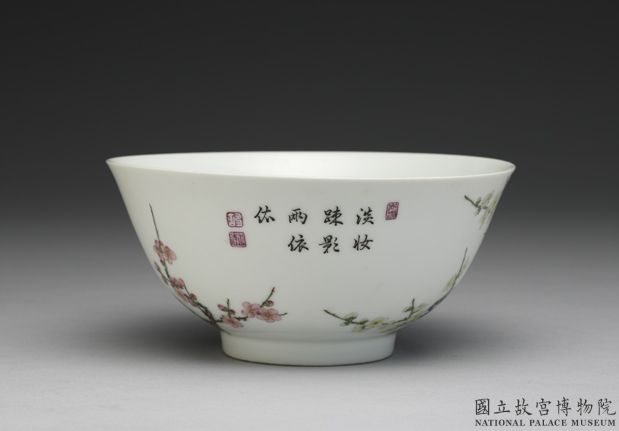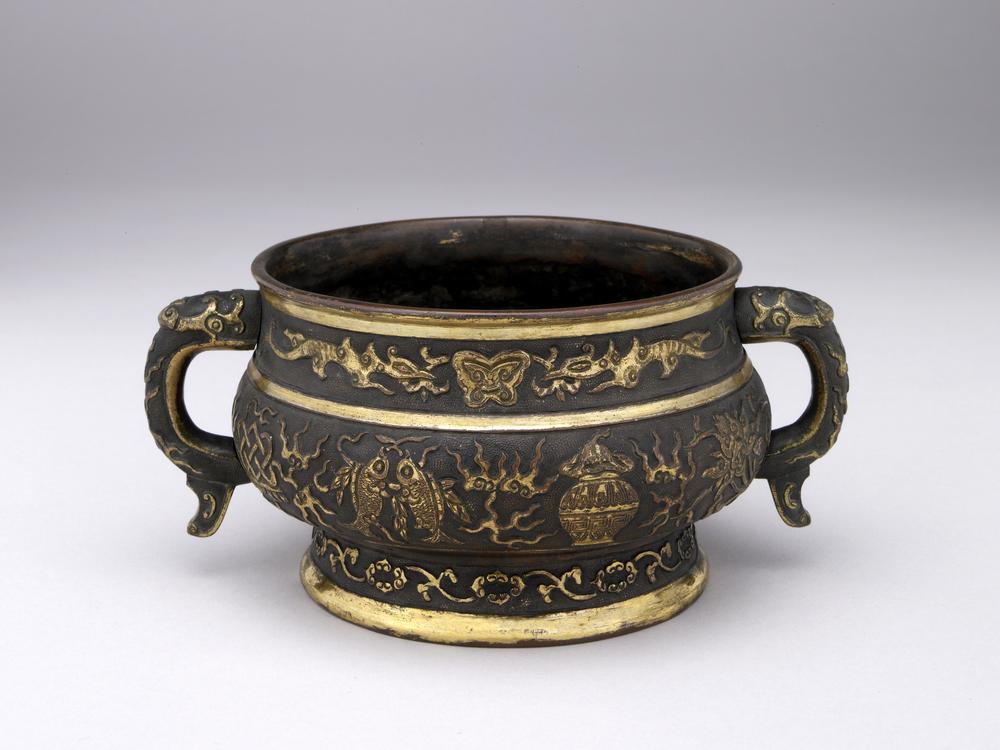Period:Ming dynasty Production date:1573 (dated)
Materials:earthenware
Technique:glazed, moulded, pierced, fahua,
Subjects:calligraphy landscape bodhisattva
Dimensions:Height: 52.60 centimetres (including base) Weight: 12.40 kilograms Width: 31.50 centimetres (including base) Depth: 18 centimetres (including base)
Description:
Architectural fitting in the form of the Bodhisattva Guanyin in a grotto with ‘fahua’-palette glazes. This is a truly remarkable documentary piece. An architectural fitting, it represents the Bodhisattva Guanyin seated at ease on a lotus seed pod in a grotto in a lotus pond. She is dressed in flowing robes, jewellery and a crown. Beside her is a Buddhist disciple with bare torso and his hands held together in prayer, kneeling on a lotus leaf. On either side of Guanyin on rocky outcrops are her attributes: a willow branch in a vase and a sutra on a cloth. Above her head is an overhanging rock with three relief characters in roundels which read, from right to left: ‘Lian chi hui’ [Festival of the Lotus Pond]. Attached to the back of the sculpture is a hollow rectangular tube which is pierced through about one third of the way down. The back is scored with a grid of guide lines for calligraphy and is incised beneath a layered turquoise and dark blue glaze. This inscription is hard to decipher as the glaze has almost obscured certain characters and the architectural fitting is repaired around the base, concealing some of the bottom line of characters.
IMG
![图片[1]-architectural fitting BM-1988-0728.1-China Archive](https://chinaarchive.net/Ming dynasty/43/mid_00254488_001.jpg)
![图片[2]-architectural fitting BM-1988-0728.1-China Archive](https://chinaarchive.net/Ming dynasty/43/mid_01055411_001.jpg)
![图片[3]-architectural fitting BM-1988-0728.1-China Archive](https://chinaarchive.net/Ming dynasty/43/mid_01055413_001.jpg)
Comments:Harrison-Hall 2001:The inscription provides a fascinating insight into the commissioning and production of votive images in the late Ming period. Unlike many of the tiles in the present catalogue, which were made for imperial palaces, imperial tombs or Buddhist temples, this architectural fitting was made for a Guanyin temple. The temple was situated in modern Shanxi province, and was presented as an offering by the whole of the Xia family. In the late Ming period, fund-raising appeals were launched by monasteries among the gentry. Monasteries were in perpetual need of funds to carry out repairs to buildings, to attract visitors and future donations. There ensued a building boom, sponsored by the gentry, which was second only to that supported by emperors in the tenth century. These literate donors sought earthly gains such as future fortune and social standing, but were also concerned with their spiritual welfare, perhaps atonement for past sins and a regard for the performance of family duties. The names of successive generations within a family of benefactors indicates long-term lineage activity.A later ‘sancai’ architectural fitting, decorated in relief with Amitabha sitting in meditative posture accompanied by two bodhisattvas, is in the Asian Art Museum, San Francisco. It is dated ‘forty-sixth year of the Wanli period’ (1615) and was similarly made in Yangcheng by later generations of the Qiao family, craftsman Qiao Yongfeng and his sons Qiao Changzheng and Qiao Changyuan, but in Tongji village.
Materials:earthenware
Technique:glazed, moulded, pierced, fahua,
Subjects:calligraphy landscape bodhisattva
Dimensions:Height: 52.60 centimetres (including base) Weight: 12.40 kilograms Width: 31.50 centimetres (including base) Depth: 18 centimetres (including base)
Description:
Architectural fitting in the form of the Bodhisattva Guanyin in a grotto with ‘fahua’-palette glazes. This is a truly remarkable documentary piece. An architectural fitting, it represents the Bodhisattva Guanyin seated at ease on a lotus seed pod in a grotto in a lotus pond. She is dressed in flowing robes, jewellery and a crown. Beside her is a Buddhist disciple with bare torso and his hands held together in prayer, kneeling on a lotus leaf. On either side of Guanyin on rocky outcrops are her attributes: a willow branch in a vase and a sutra on a cloth. Above her head is an overhanging rock with three relief characters in roundels which read, from right to left: ‘Lian chi hui’ [Festival of the Lotus Pond]. Attached to the back of the sculpture is a hollow rectangular tube which is pierced through about one third of the way down. The back is scored with a grid of guide lines for calligraphy and is incised beneath a layered turquoise and dark blue glaze. This inscription is hard to decipher as the glaze has almost obscured certain characters and the architectural fitting is repaired around the base, concealing some of the bottom line of characters.
IMG
![图片[1]-architectural fitting BM-1988-0728.1-China Archive](https://chinaarchive.net/Ming dynasty/43/mid_00254488_001.jpg)
![图片[2]-architectural fitting BM-1988-0728.1-China Archive](https://chinaarchive.net/Ming dynasty/43/mid_01055411_001.jpg)
![图片[3]-architectural fitting BM-1988-0728.1-China Archive](https://chinaarchive.net/Ming dynasty/43/mid_01055413_001.jpg)
Comments:Harrison-Hall 2001:The inscription provides a fascinating insight into the commissioning and production of votive images in the late Ming period. Unlike many of the tiles in the present catalogue, which were made for imperial palaces, imperial tombs or Buddhist temples, this architectural fitting was made for a Guanyin temple. The temple was situated in modern Shanxi province, and was presented as an offering by the whole of the Xia family. In the late Ming period, fund-raising appeals were launched by monasteries among the gentry. Monasteries were in perpetual need of funds to carry out repairs to buildings, to attract visitors and future donations. There ensued a building boom, sponsored by the gentry, which was second only to that supported by emperors in the tenth century. These literate donors sought earthly gains such as future fortune and social standing, but were also concerned with their spiritual welfare, perhaps atonement for past sins and a regard for the performance of family duties. The names of successive generations within a family of benefactors indicates long-term lineage activity.A later ‘sancai’ architectural fitting, decorated in relief with Amitabha sitting in meditative posture accompanied by two bodhisattvas, is in the Asian Art Museum, San Francisco. It is dated ‘forty-sixth year of the Wanli period’ (1615) and was similarly made in Yangcheng by later generations of the Qiao family, craftsman Qiao Yongfeng and his sons Qiao Changzheng and Qiao Changyuan, but in Tongji village.
© Copyright
The copyright of the article belongs to the author, please keep the original link for reprinting.
THE END





